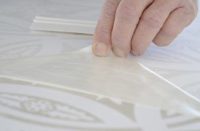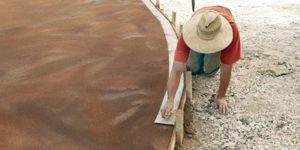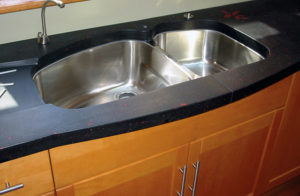 The boy looked too young to make life’s big decisions. But some have to grow up quicker than others, and this little guy was struggling, as I could tell by how he rubbed his chin and tilted his head. I patiently waited with my son and gave the lad plenty of room. A grownup and a veteran of life, I could still feel the young guy’s anguish as the seconds turned to minutes. My decision had been made well before I walked through the door.
The boy looked too young to make life’s big decisions. But some have to grow up quicker than others, and this little guy was struggling, as I could tell by how he rubbed his chin and tilted his head. I patiently waited with my son and gave the lad plenty of room. A grownup and a veteran of life, I could still feel the young guy’s anguish as the seconds turned to minutes. My decision had been made well before I walked through the door.
Finally, with a sigh, his little voice made the announcement that everyone else in line had patiently waited to hear: “I’ll have two scoops of the bubblegum ice cream on a waffle cone, please.” I simply complimented the boy on a good decision as he was given a handful of pure enjoyment.
You have, are or will make decisions on your decorative journey, and they will affect you and your family. Our industry, decorative concrete, has so many layers and many types of overlap. This magazine makes it obvious your choices are vast, but make no mistake, each decorative type requires different kinds of training, investment and manpower. Many of us have enough cash or credit to purchase an expensive polishing machine, but this doesn’t mean it is the right choice for you. Even if your market will sustain the investment, it will be a poor choice if you don’t have the marketing budget to promote it. Don’t get me wrong — I’m not saying it is the wrong choice. I’m just saying it’s the wrong choice if not well planned for. The current economy leaves little room for mistakes and I don’t want to see any contractors getting in over their heads.
The good news is, many types of decorative concrete can be learned with little capital investment. The not-so-good news is that these types see the most competition. Let’s break them down, and you can make the call of what is best for your business.
Stamped concrete
Imprinting wet concrete will replicate the look of stone, tile, wood or brick. The decision as to whether stamped concrete is the best choice for you will depend on your manpower and skill. This process is so timing-sensitive, it truly is the ultimate team sport. I recommend this type only if you enjoy challenging yourself and running a crew of skilled workers.
Good candidates for this decorative type are usually companies that are already in the concrete placement business. Don’t misunderstand this — not all crews pouring traditional concrete are a good fit for stamping it. Nevertheless, it helps to have a complete knowledge of good concrete placement before developing into a good stamping company.
Stamping doesn’t have to require boatloads of capital to start. I recommend starting out with texture stamp tools. Some companies fall into the trap of thinking they need a dozen or more patterns to offer clients and this is not true. Your customers will purchase what you offer, so take good pictures of your work. Another benefit of offering just a few patterns is that it allows your crew to master each one. I like to blend several patterns together by using accent bands or borders to give the appearance of a detailed job without the difficulty.
Competition has definitely reached the stamped concrete industry, and it’s not only coming from other concrete contractors. I can assure you it won’t be long until you find yourself bidding against pavers on many projects. This industry has worked hard to gain a strong foothold in the hardscape market and it will not be going away soon. In fact, you may want to consider incorporating pavers into your decorative concrete designs.
Stained concrete
Stained concrete is broken down into interior and exterior types. This type of decorative concrete requires less manpower and can be completed with just a crew of two. It is more mobile than most types of decorative concrete work so you can move from job to job without much effort. It is also not as timing-sensitive as most decorative concrete types, and this helps keep the blood pressure in check.
Detail-oriented folks like painters are good candidates for this type of concrete . Mastering the staining process takes a full glass of patience with a twist of artistic ability. One careless worker can set a job back hours with cleanup and rework.
The amount of capital needed to start in the stain business is minimal. It really doesn’t require expensive or heavy equipment, and this is both good and bad. It is wide open for many to enter into but few to master. I recommend tapping into the growing market of outdoor staining and then working your way indoors.
Concrete countertops
Nothing has catapulted the decorative concrete industry into the mainstream more than concrete countertops. They truly are everything that makes concrete a good venue for modern-day dwellings. They are earthy, organic, natural, and completely unique to each individual. Everyone has heard about them, and folks seem to be fascinated by the way concrete can be skillfully placed into such a useful part of everyday life. There are no shortcuts in the concrete countertop industry. It requires patience, talent, training and practice well before depositing the first dollar safely into your bank account.
Good candidates for this type are anyone who loves a challenge and has a natural flair artistically. Knowing how to pour concrete does little good, since you pour most countertops with special mixes designed for counters. Countertops combine several decorative skills, such as staining and grinding, as part of the process. I can sum up this decorative type with one word: education.
Investment in the countertop industry falls somewhere in the middle compared to other decorative types. Most counters are not poured in place, so having enough shop space is important. Countertops are poured and then left to cure, so you can imagine what happens if you have several countertop jobs going at the same time. Most contractors specializing in counters have created pour tables that allow the forming and design of countertops, molds and edges at the same time.
Having a large crew is not important until installation day rolls around. Concrete countertops are quite heavy, even after using the modern lightweight mixes. You will find out quickly who your friends are.
Polished concrete
I’m a huge fan of this type and my company doesn’t even offer it. Polished concrete is the most durable type of decorative finish. The end results are created by using big, expensive machines to grind the surface into a glassy state.
This is probably the most expensive type of decorative concrete, but it has the least competition. Generators, vacuums and polishing machines will set you back a few dollars long before blue ink shows up on your profit-and-loss statement. Job sizes are usually big and for commercial clients that like the low-maintenance aspect of polishing.
Many contractors that stain will “sell up” to polished floors if the customer can be convinced of the value.
The last word
There are many more decorative types, so do some research before jumping in. All decorative types require ongoing training, so take advantage of the ocean of knowledge available. If nothing else, you might learn what you don’t want to do before you sink hard-earned dollars into it. Let me know how it goes.
















